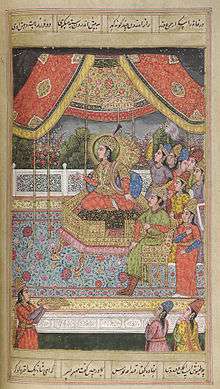Padshah Begum
Padshah Begum (Urdu: پادشاہ بیگم) was a superlative imperial title conferred upon the 'imperial' or 'First Lady' of the Mughal Empire and was considered to be the most important title in the Mughal harem or zenana.[1] This title can be equivalent with "empress" in English, but in only approximate terms in the Mughal context.
| Padshah Begum of the Mughal Empire | |
|---|---|
| Style | Her Imperial Majesty |
| Residence | Agra Fort |
| Appointer | Mughal Emperors |
| Formation | 20 April 1526 |
| First holder | Maham Begum |
| Final holder | Zeenat Mahal |
| Abolished | 14 September 1857 |
Etymology
Padeshah, Padshah, Padishah, or Badishah (Persian: پادشاه) is a superlative royal title, composed of the Persian pād "master" and the widespread shāh "king", which was adopted by several monarchs claiming the highest rank, roughly equivalent to the ancient Persian notion of "The Great" or "Great King", and later adopted by post-Achaemenid and Christian Emperors. Its Arabized pronunciation as Badshah was used by Mughal emperors, and Bashah or Pasha was used by Ottoman Sultans.
Begum, begam, baigum or beygum (Persian: بیگم, Urdu: بیگم) is a female royal and aristocratic title from Central and South Asia. It is the feminine equivalent of the title baig or bey, which in Turkic languages means chief or commander. It usually refers to the wife or daughter of a beg.
Historical usage
The title of 'Padshah Begum' could only be bestowed upon the chief or principal wife, a sister, or a favored daughter of the Mughal emperor[2] and could not be held by more than one lady simultaneously.[3] This was evidenced by the fact that Emperor Jahangir's wife, Nur Jahan, could only be given the title after his chief wife, Saliha Banu Begum (the Padshah Begum for most of his reign), had died in 1620.[1]
Where the consorts of the Mughal emperors were concerned, the title could only be bestowed upon the chief wife of the emperor. The title was first bestowed upon Maham Begum, who was the chief wife of Emperor Babur. It was held by Bega Begum during the reign of Humayun. Emperor Akbar bestowed this title on his chief wife, Ruqaiya Sultan Begum, who held the title for her whole life. Jahangir bestowed this title upon his chief wife, Saliha Banu Begum, and then to her successor (after her death), Nur Jahan Begum. Emperor Shah Jahan bestowed this title upon his chief wife, Mumtaz Mahal Begum but after she died, he bestowed it upon his daughter Jahanara Begum, and Emperor Muhammad Shah bestowed this title upon his chief wife, Badshah Begum.
The title was also bestowed upon the daughter of the emperor, such as Emperor Shah Jahan's daughter, Princess Jahanara Begum and Emperor Aurangzeb's daughter, Princess Zinat-un-Nissa, both of whom bore the title throughout their lives.[4]
In some cases the title was also bestowed upon the sister of the emperor. Such as in the case of Emperor Babur's older sister, Khanzada Begum.[5] When the princesses held the title it literally meant "Empress amongst princesses".[6]
References
- Findly, Ellison Banks (1993). Nur Jahan, empress of Mughal India. New York: Oxford University Press. pp. 95, 125. ISBN 9780195360608.
- Aftab, Tahera (2008). Inscribing South Asian Muslim Women : an Annotated Bibliography & Research Guide ([Online-Ausg.] ed.). Brill. p. 66. ISBN 9789004158498.
- The Journal of the Numismatic Society of India, Volumes 20-21. Numismatic Society of India. 1958. p. 223.
- Schimmel, Annemarie (2004). The Empire of the Great Mughals: History, Art and Culture. Reaktion Books. p. 152. ISBN 1861891857.
- Schimmel, Annemarie (2004). The Empire of the Great Mughals: History, Art and Culture. Reaktion Books. p. 145. ISBN 1861891857.
- Butenschön, Andrea (1931). The Life of a Mogul Princess: Jahānarā Begam, Daughter of Shāhjahān. Taylor & Francis. p. 221.
